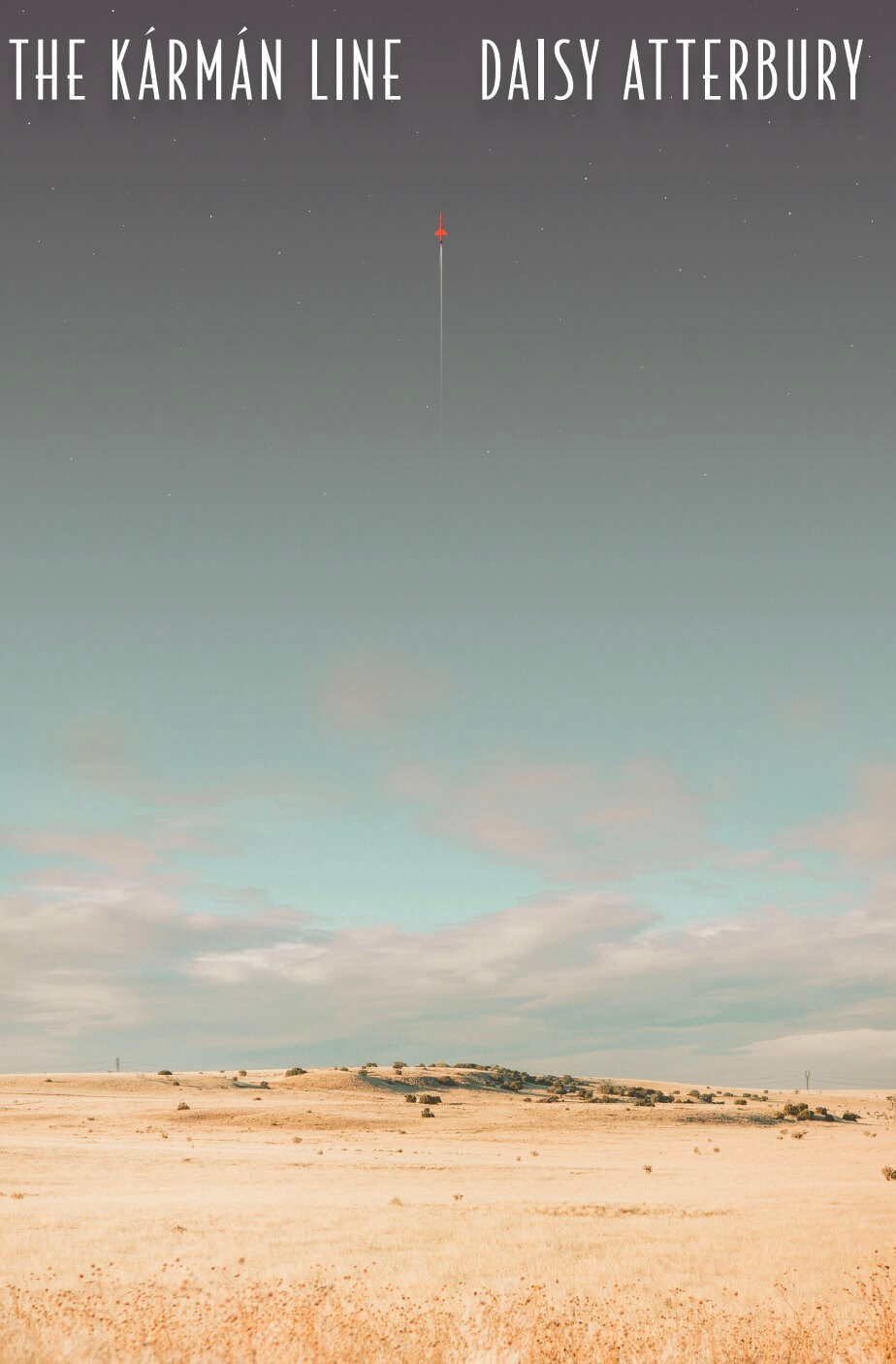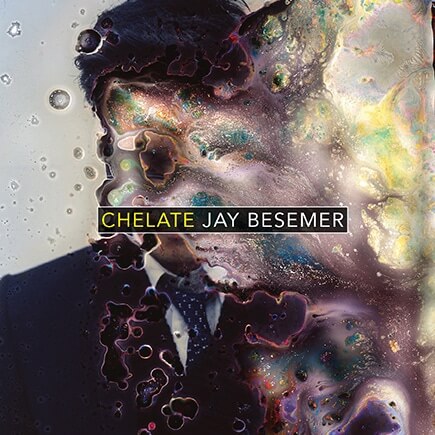
Review
Exceeding Boundaries in Daisy Atterbury’s Multi-Genre Book, The Kármán Line
Review by Gina Pugliese
Rescue Press
ISBN: 978-1-7348316-8-9
Daisy Atterbury’s The Kármán Line pointedly defies the boundaries of literary genre as it meditates on the titular line between Earth’s atmosphere and the space beyond. Above this line, Atterbury writes, “space is considered free.”[1] Below it, the planet has been carved up into politicized territories characterized by nationally recognized or preferred languages, religions, and ethnicities. As Atterbury’s book illuminates, the surface area of our globe reflects cartography linked to historical colonialism and present-day capitalism, melding space and time with social injustices, ecological disasters, and personal experiences. Fascinated with our inherited past and how it pierces into the present of the protagonist’s sojourn through New Mexican terrain, The Kármán Line orients the “I” of its poem-essay-novella toward a hazy horizon of freedom beyond the at once scientific and fabricated edge of our world. On the far side of earthly existence, identity, borders, laws, and language lose their authority to shape reality even as the mathematical certainties of time and space persist.
Yet, the book only gestures to the liberation that might come from giving up gravity for abeyance in a realm unburdened by social-political contexts. On Earth, the unnamed protagonist of The Kármán Line flits between New York and New Mexico–past and present–while eroticizing contemplations of outer space by incessantly checking dating app messages. Interrupting scientific and philosophical musings with reflections on love and loss, the narrator often synthesizes overlapping information and phenomena through bodily feeling. For instance, thinking about the “participant injury” that forms a crater, “the [measure] of trauma from transiting and colliding objects,” Atterbury writes: “I can point to the parts of my body that already know what participant injury means, what connects me to space and sex and harm.”[2] It is thus through the body that the narrator illuminates the relationship of the self to space.
Besides pondering where the Earth ends and the rest of the universe begins, Atterbury also contemplates the imagined boundaries and coherence of one’s body. Giving a poetic spin to astronomical formulas for lines and borders, Atterbury concedes that mathematical equations neither provide a firmer grasp of space nor one’s subjectivity. In the second of three sections titled “The Kármán Line,” Atterbury follows a list of equations, “calculating the Kármán line for any planet,” with a poem in which the edge of the self confronts the edge of another: “I say, What do you mean/that this problem is/Mine, that your edge pokes/my underarmpit skin.”[3] The poetic voice thereby seeks the border of their body in tandem with the Kármán line. Additionally, the speaker yearns to dissipate these boundaries, making “this problem”—of boundaries? of subjugation? of coming together?—a shared endeavor.
Throughout the book, the narrator reaches out to an absent companion who is introduced in the opening pages: “They say, No love deserves the death it has. Fuck! I see about the loss of you before we even begin.”[4] In this initial chapter, “after star death,” the speaker invokes the metaphor of star death to illustrate a lost connection. Since the light of a star travels a great distance to reach our sight, many of the stars we behold were extinguished thousands of years prior. Seeing both the beginning and end in this exact moment, the speaker delves into the melancholy of beginning something that, to exist at all, must also have an end.
This just-beginning or already-lost intimacy haunts the hazy plot of The Kármán Line. In the chapter “Everyday Silver,” the speaker tries to entice this “you” on a trip to Spaceport America, “the world’s first purpose-built Spaceport,” located near Truth or Consequences, New Mexico.[5] Sitting in the truck bed of the vehicle that the “you” plans to sell once she gets to Florida, the conversation also includes “a Mars simulation in Nevada” that the “you” has been selected to join. Eventually, the narrator embarks alone to Spaceport America while their interlocutor is dubiously positioned in either Florida or Nevada. In what follows, the book uses literary apostrophe–an address to a subject or object that is not there–to inform their missing partner about their voyage.
Throughout their trip, the speaker is compelled to impart the social-historical context of the surrounding landscape to their elsewhere friend. Crossing the Jornada del Muerto, the speaker explains that the desert was named “by Spanish conquistadors” and the site of the 1680 Pueblo Revolt.[6] Later, traveling south on I-25, the speaker says, “if you were here,” they’d tell you about Demian DinéYazhí’s sculpture, my ancestors will not let me forget this, which glows with the neon-sign message, “EVERY AMERICAN FLAG IS A WARNING SIGN.”[7] Providing context to the places they move through by drawing connections to revolts and artworks of social protest and critique, the narrator stops short of explicating these nodes of colliding epistemologies.
In this way, readers might find themselves overwhelmed by the onslaught of seemingly disconnected facts, which become their responsibility to draw deeper meaning from. Moreover, they might be frustrated in trying to hold and weave together the many historically-charged threads of the narrative. Why should they care about drawing these connections between New Mexico’s past, someone’s fascination with Spaceport America, and a personal reckoning with heartbreak? How are these things connected, and why does any of it matter?
One circumventing answer is that the book is about these very questions. When the narrator relates their family history in a section called “Backscatter,” the book more directly asks the reader to help it make sense of its disparate but interlaced storytelling. The narrator imparts: “My great-aunt was a rancher in La Madera, New Mexico. I remember my great-aunt’s memorial. Her childhood asthma brought her parents west for the air, then brought my grandparents, my parents. These are colonial stories, familial, personal, historical, social, structural.”[8] The speaker unfurls a succinct biography of Joan Atterbury, noting that she married her ranch hand and was once raped by a group of men. The narrator concludes: “I don’t know what to do with these stories.”[9] By telling these stories, though, the speaker demonstrates that they do know what to do with them–they just don’t know how to resolve them or tell all of the stories as one coherent tale.
Folding in stories of their personal history in New Mexico, the narrator conveys how their general knowledge of this land intersects with their life. As the narrator connects places such as White Sands Missile Range (where the 1945 Trinity Test of the first nuclear bomb was detonated), Los Alamos Labs (which, since performing research for the Manhattan Project, continues to design and produce nuclear weapons), and Shiprock, NM (where their “mother was a doctor for uranium miners”), the book underlines how “[r]adiation is all around us. One story betrays another.”[10] Speaking directly about how radiation poisoning impacted their family, the protagonist observes: “Water from the well tapped at my grandparents’ land has been found to contain uranium at four times the volume recommended by the health department for safe consumption . . . My mom gets cancer. It’s probably from something else.” [11]
The last line, “It’s probably from something else,” rings with irony as it ventriloquizes the voice of the US government, which has never acknowledged or intervened in the generations of contamination and death spurred by national interest in harvesting uranium for the nuclear technologies tested on lands presumed empty. “It’s an eternally unfulfilled wish, that governments could make amends,” Atterbury writes in the section “Uranium Yellow.”[12] Additionally, in a final section, “Meltdown,” when the speaker asserts, “I want to deal with this history, my exposure to it,” they mean a very real and deadly one.[13]
Sometimes ironic in tone, the book distances itself from anger, preferring lamentation, disappointment, and hope instead. In the end, Spaceport America disappointingly turns out to be little more than a tourist trap with a closed cafe. Yet, returning to Albuquerque, the narrator reunites with their missing partner in order to conclude the text with a congenial “goodbye,” pointing to the hope for other beginnings.[14]
Ultimately, The Kármán Line never breaches this line, even as the table of contents promises to take us through each region of the atmosphere–from the troposphere (the lowest region) to the exosphere (the highest). Indeed, some readers might be let down that Atterbury neither delivers on nor explains the impossibility of delivering on the notions of freedom and completion she flirts with. Personally, I’m still investigating if the book left me frustrated in its lofty and directionless musings or if it lit a deep curiosity in me that will take time to experience star death. It certainly succeeded in leaving me with the sensation of having traveled into the desert and its past. In this way, I, like the narrator, am making sense of Atterbury’s prose in my body, experiencing a subtle buoyancy as I try to connect the dots and form constellations of meaning.
[1] Atterbury, Kármán Line, 18.
[2] Atterbury, Kármán Line, 38.
[3] Atterbury, Kármán Line, 94-6.
[4] Atterbury, Kármán Line, 18.
[5] “The Gateway to Space,” Spaceport America. Accessed 14 December 2024. https://www.spaceportamerica.com/
[6] Atterbury, Kármán Line, 54.
[7] Atterbury, Kármán Line, 73.
[8] Atterbury, Kármán Line, 89.
[9] Atterbury, Kármán Line, 90.
[10] Atterbury, Kármán Line, 72 and 123.
[11] Atterbury, Kármán Line, 120.
[12] Atterbury, Kármán Line, 73.
[13] Atterbury, Kármán Line, 159.
[14] Atterbury, Kármán Line, 164.
About the Author
 Gina Pugliese is a writer who was raised in Wyoming and lives in Albuquerque, New Mexico. After obtaining her Ph.D. in English literature, she avoided the academic job market by getting her cosmetology license and cutting hair. No longer acting as an amateur therapist, she often contributes art journalism to Southwest Contemporary and other publications.
Gina Pugliese is a writer who was raised in Wyoming and lives in Albuquerque, New Mexico. After obtaining her Ph.D. in English literature, she avoided the academic job market by getting her cosmetology license and cutting hair. No longer acting as an amateur therapist, she often contributes art journalism to Southwest Contemporary and other publications.



